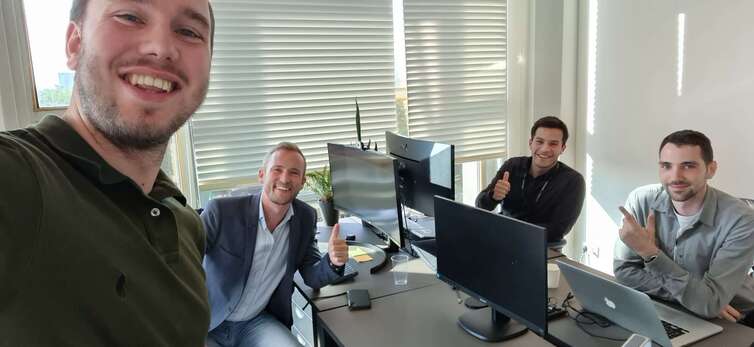11 Tips for Helping New Hires Adapt to Your Company’s Tech
Get the latest updates about our blog posts.
Subscribe so you don’t miss out!
Follow Lizard Global on Facebook, Instagram and LinkedIn for the latest updates.
Adaptability in the workplace; there are distinctive importance and benefits that organizations tend to overlook. Sure, adaptability comes with time, but throughout that process, how can you as Executives help accelerate new employees to adapt to new technologies?
Digital transformation is happening all around us, and technological innovations are taking over a continuously increasing amount of tasks and internal business processes. The automation of business processes doesn’t just happen overnight. On the contrary, it takes time and effort to prepare your employees for the adoption of new technology within their daily routines.
User adoption, sometimes referred to as onboarding, is the process by which new users become acclimated to a product or service and decide to keep using it. Initially, this process confusion and churn in an organization, especially when employees aren’t being guided toward these new changes. Lack of guidance or a proper preparation strategy is likely to result in frustration, dissatisfaction, and chaos among employees and customers - which is exactly what you wanted to prevent with the implementation of improved technology.
What are the challenges of technology adoption?
The adoption of new technologies in a fully functional business environment can be challenging. Unfortunately, it’s not simply a matter of implementing new technology and expecting everything to immediately work smoothly. The process of business process automation takes time and effort. Not only from you but also from so your employees. The entire organization and team have to be motivated and invested enough to dedicate a significant portion of their time to learning these new technologies. All stakeholders need to understand the functionalities of these technologies and be able to see the bigger picture of technological changes and their impact on daily tasks and working life in general.
Getting the whole organization aware of and used to the newly adopted technologies is just the start of a successful process. The rates of technological innovations are skyrocketing; therefore, continuous change is inevitable. This requires your employees to be ready for change at every moment. They have to be able to easily adapt to new technologies without having to start from scratch every time new technology is implemented. This can be difficult, especially for older generations who aren’t used to working with technology as much as younger generations. Some people may be less inclined to adopt new technologies in their daily tasks because they are used to doing these tasks manually, which has worked perfectly fine in the past.
Generally, there are two ways new technology influences the ease of user adoption, based on the Technology Acceptance Model:
- Perceived Usefulness (PU)
- Perceived Ease-Of-Use (PEOU)
Perceived Ease-Of-Use can be defined as the “degree to which a person believes that using a particular system would be free from effort”. PEOU reflects the ease of using new technology. How much time and effort you would have to invest in learning how to use this technology influences your attitude towards it.

11 essential tips to improve workplace technology adoption
A good strategy for user adoption can immensely boost your internal business processes and your company’s success. Automation can take over tedious tasks that had to be done manually before, which saves time and money that can be used to re-invest in more important business needs. Here are some tips and tricks that can help with the guidance of your employees toward user adoption.
1. Prepare your organization for emerging technologies
New technology can have a significant impact on your organization, its structure, and internal processes. Therefore, it’s of great importance to not immediately dive into the adoption of something entirely new without a coherent strategy:
- Map out your current business processes and see what aspects will most likely undergo the biggest transformation.
- Visualize the new processes in order to have a clear overview of the end-goal.
- Identify implications and risks, as every kind of change will inevitably bring some issues along with it. So make sure proactively plan and prepare for it.
- Structure your new ways of working in such a way it’s prepared for possible implications and risks, so it doesn’t negatively impact your progress.
2. Apply a phased adoption strategy
Because change does not happen overnight, the best way to work towards the adoption of new technology is to roll it out gradually. Give employees enough time to familiarize themselves with the changes. The more they get used to the new processes, the more willing they are to use these new technologies. After you have identified and visualized the different changes, create a concrete step-by-step plan to make sure the changes do not take place too rapidly and that the employees aren’t surprised.
3. Identify your influencers
Important to realize is that not all users and employees will easily adopt new technologies into their daily activities. Both early adopters and more reluctant employees can have a massive impact on the success or failure of the implementation of new technologies. Use the influencers to guide and influence the reluctant groups to use and buy into the new technologies.
4. Integrate your culture into the new way of working
Every business is unique and has its character. Make sure that the technological changes that’ll take place fit the culture of your organization. Does your company heavily rely on teamwork and communication? New technology should enhance this quality, rather than diminish it.
5. Role of critical stakeholders in new technology adoption
Once you have mapped out the people who will use the newly implemented technologies, you can identify who are the most critical stakeholders, and create an education program that works best for them. Users should not only know how to use technology, but they also need to understand the goal and benefits of the implemented digital change. If a user understands the goal and benefits of new technology, they are much more likely to buy into and accept the change that comes along.
6. Put a support infrastructure in place
Errors and bottlenecks are inevitable during the process of introducing and implementing new technologies in your organization. Make sure you have a proper support network in place to help people who get stuck or have questions.
7. Set realistic expectations
As noted before, Rome was not built in one day and changes like these do not just happen overnight. Your organization cannot adapt to wholesale technology changes within one month. Therefore, realistic goals and measurable targets should be set to let stakeholders get used to the specific change and adapt to it.
8. Monitor engagement and track attitudes
Next to tracking goals and targets, it is crucial to monitor the journey of users toward that specific goal. User engagement and personal attitudes are two of the most important indicators of a successful adoption process. User engagement can be measured by providing user behavior analytics, whereas personal attitudes should come from qualitative research through interviews.
9. Evaluate new technology and enhance adoption strategies
As soon as you evaluate the different KPIs, bottlenecks can be identified and improvements can be implemented based on a thorough analysis. Facilitating these steps constantly, results in a continuous and Agile adoption process.
10. Convince skeptical employees by making it fun!
Gamification is increasingly used to turn difficult or tedious tasks into enjoyable interactive activities. Applying a gamified way of working where you reward your employees for utilizing new technology will stimulate engagement and increase the likelihood that your employees adopt new technologies without reluctance.
11. Implement openness to new ideas in organizational culture
If an inherent openness or willingness to change is integrated into your company culture, managing and implementing new technology becomes much less of a struggle. A change in business culture will most likely happen over a longer period, which means that even way before the implementation of new technologies, it’s essential to prepare employees for possible future changes. This can be done by, for example, educating the team about the benefits of technology in other businesses, and trying out informal ways of interacting with technology.

How we succeed at user adoption at Lizard Global
As you can see, the benefits of user adoption are not to be overlooked. Your business, employees, and customers can greatly benefit from the implementation of new and improved technology within your organization. At Lizard Global, we facilitate the process of user adoption in the entire process of product development. Not only are we experienced in adopting new technologies in our business processes, but we’ve also helped different organizations with their digital transformation.
Additionally, in our Lean Startup Methodology , we involve the end-user in the early stages of development to get valuable feedback about the ease of interaction with new technologies. We ensure that this feedback is implemented in the solution we provide, and new users can interact with the product without taking too much time to get familiar with the technology.
Need a hand?
Want to deep dive into how you can develop and improve the implementation of effective user adoption? Feel free to contact us at any time, and we’ll be happy to help and guide you and your business through the process of automation.





